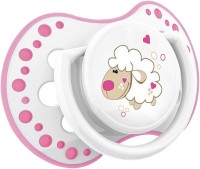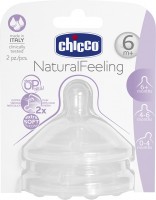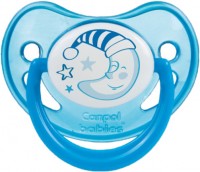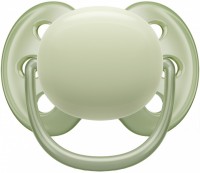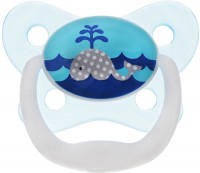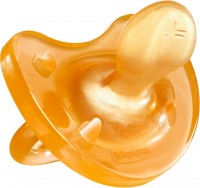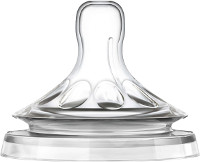Bottle Teats & Pacifiers Canpol Babies
All models Advanced filters → |
You might be interested in
Bottle Teats & Pacifiers: specifications, types
Type
— Pacifier. A nipple is an attachment for a bottle of milk or nutritional fluid intended for feeding a baby. In fact, the nipple replaces the mother's breast for the child: this attachment has a characteristic shape and is made of soft material, and power supply is supplied through a small hole. Thanks to this, you can feed even newborn babies (the sucking reflex is innate).
- Dummy. Like a pacifier, a pacifier is essentially an imitation of the mother's nipple - however, in accordance with the name, such an imitation is made empty and is purely a dummy. Pacifiers are used as a sedative: sucking distracts and calms the baby, but giving him the breast or feeding from a pacifier every time is impossible to avoid overeating, and this is not always possible. Among doctors and other specialists one can find different attitudes towards this device, but in practice it all depends on how long and often the pacifier is used. Definitely, its use should not be abused - this can lead to some problems in the development of the baby; on the other hand, if the baby does not satisfy the need to suck with a pacifier, he will inevitably put other objects in his mouth.
— Silicone nibbler. Nibblers are specific devices designed for feeding a baby - that is, for giving him solid food, gradually accustoming him to it. Outwardly, such devices are similar to pacifiers, but in...stead of a nipple, a larger nozzle with holes is installed on the nibbler. You need to place food inside such a nozzle, close it securely, knead the contents - and the nibbler can be given to the child. When a baby chews such a “yummy”, the contents seep through the holes in the nozzle, but large hard pieces remain inside. Thus, starting your acquaintance with “adult” food with a nibbler is much safer than doing it “just like that”, without additional devices.
The working part of the nibblers can be made from different materials; in this case, soft food grade silicone is used. This attachment looks like a large pacifier with holes made in it. Compared to another type of attachment - mesh (see below) - silicone is considered more convenient and hygienic: it does not darken from “colored” fruits, is easy to clean and even tolerates boiling. At the same time, the choice of material depends primarily on the child’s preferences: some children prefer silicone nibblers, others prefer mesh.
— Nibbler with mesh. Nibblers with a nozzle in the form of a bag made of fabric mesh. For more information about nibblers in general, see above. Here we note that such a nozzle is not as convenient to use and clean as a silicone one, it is less durable, but it costs a little less, and replacement meshes are more common on sale. Be that as it may, such devices are also quite convenient, practical and safe. So if the baby himself likes the mesh more than the silicone nozzle, you can safely use just such a nibbler.
- Dummy. Like a pacifier, a pacifier is essentially an imitation of the mother's nipple - however, in accordance with the name, such an imitation is made empty and is purely a dummy. Pacifiers are used as a sedative: sucking distracts and calms the baby, but giving him the breast or feeding from a pacifier every time is impossible to avoid overeating, and this is not always possible. Among doctors and other specialists one can find different attitudes towards this device, but in practice it all depends on how long and often the pacifier is used. Definitely, its use should not be abused - this can lead to some problems in the development of the baby; on the other hand, if the baby does not satisfy the need to suck with a pacifier, he will inevitably put other objects in his mouth.
— Silicone nibbler. Nibblers are specific devices designed for feeding a baby - that is, for giving him solid food, gradually accustoming him to it. Outwardly, such devices are similar to pacifiers, but in...stead of a nipple, a larger nozzle with holes is installed on the nibbler. You need to place food inside such a nozzle, close it securely, knead the contents - and the nibbler can be given to the child. When a baby chews such a “yummy”, the contents seep through the holes in the nozzle, but large hard pieces remain inside. Thus, starting your acquaintance with “adult” food with a nibbler is much safer than doing it “just like that”, without additional devices.
The working part of the nibblers can be made from different materials; in this case, soft food grade silicone is used. This attachment looks like a large pacifier with holes made in it. Compared to another type of attachment - mesh (see below) - silicone is considered more convenient and hygienic: it does not darken from “colored” fruits, is easy to clean and even tolerates boiling. At the same time, the choice of material depends primarily on the child’s preferences: some children prefer silicone nibblers, others prefer mesh.
— Nibbler with mesh. Nibblers with a nozzle in the form of a bag made of fabric mesh. For more information about nibblers in general, see above. Here we note that such a nozzle is not as convenient to use and clean as a silicone one, it is less durable, but it costs a little less, and replacement meshes are more common on sale. Be that as it may, such devices are also quite convenient, practical and safe. So if the baby himself likes the mesh more than the silicone nozzle, you can safely use just such a nibbler.
Quantity
Number of individual teats or pacifiers supplied in the kit; only indicated if there is more than one item.
Buying a set of several products can be convenient not only for several children (for example, twins), but also for one child: baby accessories need to be washed and sterilized periodically, and after sending one pacifier or pacifier to the sink, you can use another, clean one. Most "multi-charge" sets include 2-3 pacifiers / pacifiers, less, but there are also sets for as many as 20 units — they are mainly intended for neonatal departments, nurseries, etc.
Buying a set of several products can be convenient not only for several children (for example, twins), but also for one child: baby accessories need to be washed and sterilized periodically, and after sending one pacifier or pacifier to the sink, you can use another, clean one. Most "multi-charge" sets include 2-3 pacifiers / pacifiers, less, but there are also sets for as many as 20 units — they are mainly intended for neonatal departments, nurseries, etc.
Age
The age for which the pacifier / pacifier is designed, more precisely, the minimum age from which it can be used. Age is indicated in months: for example, 6+ means that the product can be used from six months.
In the first months of life, the growth and development of the child is very fast, in fact, every month brings something new. Therefore, it is impossible to deviate from age recommendations: a nipple / pacifier chosen not for age will be uncomfortable at best, and even harmful or even dangerous.
Note that models are also produced for children born prematurely; such products are labeled accordingly.
Now there are such age recommendations: for premature babies, for newborns (0m+), from 1 month (1m+), from 2 months (2m+), from 3 months (3m+), from 4 months (4m+), from 6 months (6m+), from 9 months (9m+), from 12 months (12m+), from 18 months (18m+).
In the first months of life, the growth and development of the child is very fast, in fact, every month brings something new. Therefore, it is impossible to deviate from age recommendations: a nipple / pacifier chosen not for age will be uncomfortable at best, and even harmful or even dangerous.
Note that models are also produced for children born prematurely; such products are labeled accordingly.
Now there are such age recommendations: for premature babies, for newborns (0m+), from 1 month (1m+), from 2 months (2m+), from 3 months (3m+), from 4 months (4m+), from 6 months (6m+), from 9 months (9m+), from 12 months (12m+), from 18 months (18m+).
Shape
The general shape of a pacifier or pacifier (see "Type").
- Round. The classic round shape is convenient because the pacifier can be given in any direction. Yes, these models are the cheapest. On the other hand, it is believed that long-term use of a round nipple can lead to a malocclusion.
- Anatomical. The papilla on the anatomical nipple or pacifier is flattened or elongated, most often it has the shape of an ellipse. It is believed that such products evenly distribute the pressure on the palate, contribute to the formation of a correct bite and prevent the swallowing of air.
- Orthodontic. A nipple/dummy with a beveled papilla, flattened at the bottom and convex at the top. This form is considered the most correct in terms of anatomy and physiology, but also in terms of convenience for the child (although this moment, of course, is individual). An orthodontic nipple/pacifier takes up minimal space in the mouth, reduces the risk of tooth and palate deformity to almost zero, and contributes to the formation of a correct bite.
Note that when choosing a shape, it is worth considering not only theoretical recommendations, but also the preferences of the baby himself. It happens that an orthopedic or anatomical model that is perfect in shape (theoretically) simply does not like the child, and the simplest round dummy turns out to...be the most desirable option. That is why all three forms are still relevant.
- Round. The classic round shape is convenient because the pacifier can be given in any direction. Yes, these models are the cheapest. On the other hand, it is believed that long-term use of a round nipple can lead to a malocclusion.
- Anatomical. The papilla on the anatomical nipple or pacifier is flattened or elongated, most often it has the shape of an ellipse. It is believed that such products evenly distribute the pressure on the palate, contribute to the formation of a correct bite and prevent the swallowing of air.
- Orthodontic. A nipple/dummy with a beveled papilla, flattened at the bottom and convex at the top. This form is considered the most correct in terms of anatomy and physiology, but also in terms of convenience for the child (although this moment, of course, is individual). An orthodontic nipple/pacifier takes up minimal space in the mouth, reduces the risk of tooth and palate deformity to almost zero, and contributes to the formation of a correct bite.
Note that when choosing a shape, it is worth considering not only theoretical recommendations, but also the preferences of the baby himself. It happens that an orthopedic or anatomical model that is perfect in shape (theoretically) simply does not like the child, and the simplest round dummy turns out to...be the most desirable option. That is why all three forms are still relevant.
Flow rate
The rate of nutrient flow provided by the nipple (see “Type”), in other words, the rate at which the baby can absorb liquid food through the nipple. This parameter is very important for convenience when feeding: if the speed is too high, the child will choke and swallow air (which is fraught with belching and gas), if feeding is too slow, it can be naughty. However, in general, we can say that a low speed is generally preferable to a high one. So, for newborns, you should definitely use “slow” models — otherwise the baby simply will not have time to swallow food. As the child grows, it is possible to transfer to teats with larger holes and higher flow rates ; however, this should not be done by force — it's okay if the baby prefers not to rush when eating and does not want to switch from a “slow” nipple to a “fast” one.
There are models in which the flow rate can be adjusted ; such nipples are the most versatile and can be used in all age categories, however, they are more expensive than ordinary, “single-speed” ones.
There are models in which the flow rate can be adjusted ; such nipples are the most versatile and can be used in all age categories, however, they are more expensive than ordinary, “single-speed” ones.
Bottle neck size
The size of the bottle neck for which the pacifier is designed (see "Type").
Baby bottles are available in two standard neck sizes — standard and wide. The size of the pacifier must match the diameter of the neck, otherwise it will not be possible to use the product normally with this bottle.
Baby bottles are available in two standard neck sizes — standard and wide. The size of the pacifier must match the diameter of the neck, otherwise it will not be possible to use the product normally with this bottle.
Material
The main material used in the construction of the pacifier/pacifier, more specifically the material from which the nipple is made, is the part that the baby puts into his mouth when he uses it.
— Latex. Natural rubber material. Latex is less strong and durable than silicone, although it still tolerates stretching and even biting quite well. In addition, it has a specific smell and taste, and although it is hypoallergenic, due to its natural origin, there is still a certain probability of an allergy to such a product (although this probability is extremely low). Therefore, latex nipples/pacifiers are not recommended for children with an increased tendency to allergies. On the other hand, latex products are softer and more flexible, perfect for babies who "didn't appreciate" silicone nipples. Yes, and the price of this material is lower.
— Silicone. Strong and durable material, which is also completely neutral and does not cause allergies. Silicone has no taste and smell, and heat resistance allows it to be sterilized in boiling water. On the other hand, such nipples/pacifiers are more rigid than latex, and some children do not want to take them, and this material is more expensive.
— Latex. Natural rubber material. Latex is less strong and durable than silicone, although it still tolerates stretching and even biting quite well. In addition, it has a specific smell and taste, and although it is hypoallergenic, due to its natural origin, there is still a certain probability of an allergy to such a product (although this probability is extremely low). Therefore, latex nipples/pacifiers are not recommended for children with an increased tendency to allergies. On the other hand, latex products are softer and more flexible, perfect for babies who "didn't appreciate" silicone nipples. Yes, and the price of this material is lower.
— Silicone. Strong and durable material, which is also completely neutral and does not cause allergies. Silicone has no taste and smell, and heat resistance allows it to be sterilized in boiling water. On the other hand, such nipples/pacifiers are more rigid than latex, and some children do not want to take them, and this material is more expensive.
For thick liquids
Teats suitable for use with thick liquids such as cereals. For this, an appropriate hole size is provided, and such a product is poorly suited for liquid contents — the contents of the bottle will pour out too quickly. This must be taken into account when choosing.
Night
Models designed for use at night. A distinctive feature of such products is the presence of inserts that glow in the dark — thanks to this, the parent can find the pacifier (for example, to pick it up) without turning on the light and without disturbing the baby once again. And the light from the insert is not visible to the child himself. Only pacifiers are available at night (see "Type"), because for nipples, this function is not needed.
Nibbler handle
The type of handle the nibbler is equipped with (see "Type").
— Direct. In this case, we mean elongated handles, not related to rings or Y-shaped (see below). The form itself can be both simple and quite complex (anatomical, in the form of a figure, etc.). Anyway, these handles are simple and at the same time quite functional and safe.
— Round (ring). The ring-shaped handle is good because the child can grasp it tenaciously. In addition, if the baby accidentally opens his hand, the nibbler can be put on one of the fingers instead of falling to the floor, crib, etc.
— Y-shaped. Y-shaped handle with two "horns" into which the handle is divided. The main advantage of this design is that the baby can comfortably hold the handle with both hands at once. In addition, these pens look funny, they can be given different interesting shapes — for example, rabbit ears. There are also Y-shaped handles in the form of a pair of rings.
— Direct. In this case, we mean elongated handles, not related to rings or Y-shaped (see below). The form itself can be both simple and quite complex (anatomical, in the form of a figure, etc.). Anyway, these handles are simple and at the same time quite functional and safe.
— Round (ring). The ring-shaped handle is good because the child can grasp it tenaciously. In addition, if the baby accidentally opens his hand, the nibbler can be put on one of the fingers instead of falling to the floor, crib, etc.
— Y-shaped. Y-shaped handle with two "horns" into which the handle is divided. The main advantage of this design is that the baby can comfortably hold the handle with both hands at once. In addition, these pens look funny, they can be given different interesting shapes — for example, rabbit ears. There are also Y-shaped handles in the form of a pair of rings.
In box
Additional items included in the design or delivery of the pacifier/pacifier.
— Cap. Protective cap that can be put on the nipple during non-working hours. This greatly simplifies the storage of the product: the cap protects against contamination and may be useful even if the nipple / pacifier is simply lying in an open place (because dust can settle on it), not to mention troubles like falling on the floor. However, the cap is suitable only for a short stay in the open; for long-term storage, it is better to use a container (see below) or at least an impromptu case.
— Ring. The handle in the form of a ring is equipped exclusively with pacifiers. Such a handle is convenient for parents — in particular, you can quickly and effortlessly remove the pacifier from your mouth, even if the child actively objects to this. At the same time, pacifiers without a ring are also available — they are more compact and better suited for active babies who may not release their nipples while on the move.
— Chain. A device for hanging a pacifier around the neck (only they are equipped with chains, such equipment does not make sense for nipples). Note that the name "chain" is conditional, most often it is not a metal chain (uncomfortable or even dangerous for a child), but a narrow ribbon made of soft fabric.
— Container.... Special container for storing and carrying nipples/pacifiers. Like the cap described above, it is primarily intended to protect against contamination; the pacifier/pacifier fits into the container as a whole, making this option perfect for long-term storage. Of course, improvised packaging can also be used for such storage; however, a complete container is generally more convenient and hygienic.
— Additional nozzle / mesh. Optional silicone cap or mesh supplied with nibbler (see "Type"). As you use the nibblers inevitably wear out, besides, the child can simply chew on the nozzle. Instead of buying a new nibbler, it is easier and cheaper to change its working part; the presence of a nozzle / mesh in the kit eliminates the need to buy a replacement part separately. This is especially convenient for silicone nibblers — spare nozzles for them are quite rare on the market.
— Cap. Protective cap that can be put on the nipple during non-working hours. This greatly simplifies the storage of the product: the cap protects against contamination and may be useful even if the nipple / pacifier is simply lying in an open place (because dust can settle on it), not to mention troubles like falling on the floor. However, the cap is suitable only for a short stay in the open; for long-term storage, it is better to use a container (see below) or at least an impromptu case.
— Ring. The handle in the form of a ring is equipped exclusively with pacifiers. Such a handle is convenient for parents — in particular, you can quickly and effortlessly remove the pacifier from your mouth, even if the child actively objects to this. At the same time, pacifiers without a ring are also available — they are more compact and better suited for active babies who may not release their nipples while on the move.
— Chain. A device for hanging a pacifier around the neck (only they are equipped with chains, such equipment does not make sense for nipples). Note that the name "chain" is conditional, most often it is not a metal chain (uncomfortable or even dangerous for a child), but a narrow ribbon made of soft fabric.
— Container.... Special container for storing and carrying nipples/pacifiers. Like the cap described above, it is primarily intended to protect against contamination; the pacifier/pacifier fits into the container as a whole, making this option perfect for long-term storage. Of course, improvised packaging can also be used for such storage; however, a complete container is generally more convenient and hygienic.
— Additional nozzle / mesh. Optional silicone cap or mesh supplied with nibbler (see "Type"). As you use the nibblers inevitably wear out, besides, the child can simply chew on the nozzle. Instead of buying a new nibbler, it is easier and cheaper to change its working part; the presence of a nozzle / mesh in the kit eliminates the need to buy a replacement part separately. This is especially convenient for silicone nibblers — spare nozzles for them are quite rare on the market.
Country of origin
The country of origin of the brand under which the product is marketed. Often indicated by the nationality of the company or the location of its headquarters. At the same time, the actual production capacity of the brand often differs from the country of origin.
It should be noted that the quality of products depends not so much on geography, but on the peculiarities of the organization of processes and quality control at all stages of production. Therefore, national prejudices regarding brands from certain regions, as a rule, are not supported by anything. It is necessary to pay attention to the country of origin of the brand only if the task is to fundamentally support or bypass the manufacturer from a particular state.
It should be noted that the quality of products depends not so much on geography, but on the peculiarities of the organization of processes and quality control at all stages of production. Therefore, national prejudices regarding brands from certain regions, as a rule, are not supported by anything. It is necessary to pay attention to the country of origin of the brand only if the task is to fundamentally support or bypass the manufacturer from a particular state.


